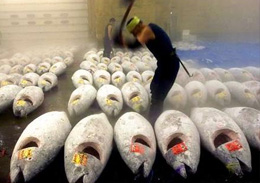|
||||||||||||
|
||||||||||||
Blue Fin in Crisis |
|
|||||||||||||||||

|
It was a sad day for us here at Moshi Moshi when the Bluefin tuna failed to make the UN’s list of protected fish at the meeting of the Convention of International Trade in Endangered Species (CITES) in Qatar. Moshi Moshi has been at the forefront of campaigns to stop serving Bluefin, and we took it off our menus in 1999. But perhaps the wider world can be forgiven for ignoring the plight of this amazing fish for so long. While other endangered species have more than a dash of celebrity charisma – the kohl-eyes of the panda, or those smoldering, sinewy rock stars of the animal world, the tigers. If you say ‘tuna’ to most people, they immediately think ‘mayo’, and the soggy sandwiches lurking in the work canteen. In the deep ocean the tuna fish has perfected its role as one of the unsung athletic superstars of the natural world: fully mature Bluefin Tuna commonly reach a massive 250 kg and can slice through the water at up to 70 miles per hour. They are so powerful they can use the energy generated by their muscles – the flesh that is canned and sold as a cheap baked potato filling – to raise their body temperature above the water around them, allowing them to hunt in cooler waters. As a result of this remarkable adaptability shoals are found all over the world. They perform a vital part of ocean ecosystems as top-level predators, and the numbers of tuna found can be taken as an indication of the health of the seas right down to the microscopic phytoplankton at the bottom of the food chain. Or at least it could be, if humans hadn’t devastated the numbers of these amazing fish through overfishing. Since the 1950s, when large-scale commercial fishing of the Southern Bluefin began, stocks are estimated to have declined by 92 per cent. Atlantic stocks are estimated to have been reduced by 90 per cent since the 1970s. As a result all species of Bluefin Tuna around the world are now regarded as either critically endangered or vulnerable. The reasons are obvious: tuna can command an extremely high price and the global Bluefin business is a multi-billion pound industry. The fish is so popular in sushi, particularly sashimi, that one 232 kg giant Bluefin sold for 16.28 million yen (£121k) at auction in Tokyo in January 2010. With prices like this the number of boats setting sail in search of tuna has increased enormously in recent decades as North and West African fleets joined European, Australian, American and Asian boats in a poorly regulated free-for-all. While a trend towards fish ranching has meant many young Bluefin are taken out of the wild, pushing the species into a position where extinction becomes even more of a possibility. The announcement of a potential ban on the international commercial trade of Atlantic Bluefin tuna would have been great news – but now it’s just a shame the species will be pushed further to the brink before anything happens. But we haven’t given up yet, and hope that the media attention on the tragic recent history of the tuna will be a first step towards a better future for the Bluefin. Only then can we look forward to a world where these beautiful creatures are guaranteed a future. You can now follow us on facebook at Moshi Liverpool Street. |
|||||||||||||||||
 |